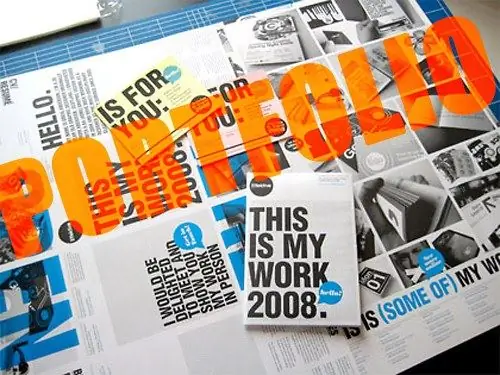A well-crafted portfolio is a visiting card of any designer. In many ways, it is samples of work, and not documents on obtaining an education at a prestigious educational institution or an impressive track record, that determine the choice of a client when looking for a designer to implement a particular project. To form a good portfolio, you need to know what works to include in it, where and in what format to present it. You also need to clearly understand what audience it is designed for, what tasks it should solve.

Instructions
Step 1
Determine who you are going to present your portfolio to. Usually, it is required to show creative designs among potential customers, that is, when advertising your services. Also, an important factor for a designer is the recognition of his talent and creative success among colleagues in the "design shop" - for this, you also need to declare yourself.
Step 2
If we are talking about potential customers of design services, then the portfolio should contain exactly those works that best tell about you as a performer. Include in it projects that have already found their embodiment in the material or on the Internet.
Step 3
Show the process of creating each project step by step. Describe the goals that the client set for you. It will be interesting for a potential customer to see the process of your work and the compliance of the final result with the task set initially. Indicate which projects were accepted by the client and which were not (if you include them in the portfolio), as well as which were completed for participation in a tender or competition.
Step 4
Choose only the best samples. Let them be few (no more than ten), but they should be diverse. Show your full range of skills - from logo drawing to website design.
Step 5
When forming a portfolio, place the strongest works at its beginning and at the end, because human perception is arranged in such a way that the first and last impressions leave the greatest imprint on it - use this effect.
Step 6
To impress fellow designers, the presentation of your creations should have a slightly different concept: here you can give room for a bold design thought. Make your portfolio stand out and express your personality.
Step 7
Methods here can be very diverse - from graphics in the author's technique, non-standard format or form to the use of unexpected materials and media. Also, in a portfolio of a purely creative nature, your original poems, prose or interesting aphorisms may look quite organic. All this creativity, bordered by your own illustrations or collages, can favorably distinguish you from the crowd and bring well-deserved recognition among colleagues and connoisseurs.
Step 8
When choosing a presentation format for your work, be guided by your profile. If you work with printing, then a “paper” - printed - portfolio will be the most logical choice. If you are a web designer your projects are best presented online. It is best to choose a PDF or PowerPoint format for mailing samples of work along with a resume, and take a printed version for a personal interview.
Step 9
In any case, your portfolio should have a simple and understandable structure (by date of creation, by clients, by category). Let the works speak for themselves - no additional questions should arise when examining them.






